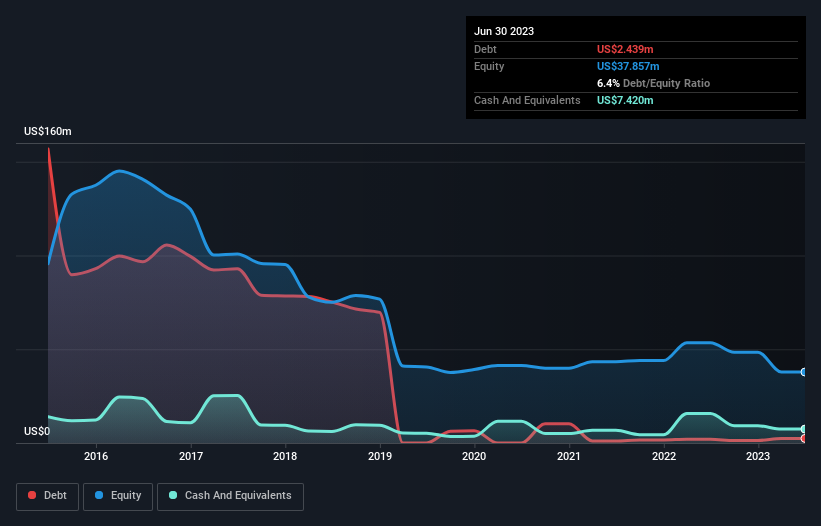The external fund manager backed by Berkshire Hathaway's Charlie Munger, Li Lu, makes no bones about it when he says 'The biggest investment risk is not the volatility of prices, but whether you will suffer a permanent loss of capital.' When we think about how risky a company is, we always like to look at its use of debt, since debt overload can lead to ruin. We note that Wellard Limited (ASX:WLD) does have debt on its balance sheet. But the real question is whether this debt is making the company risky.
When Is Debt Dangerous?
Debt is a tool to help businesses grow, but if a business is incapable of paying off its lenders, then it exists at their mercy. If things get really bad, the lenders can take control of the business. However, a more common (but still painful) scenario is that it has to raise new equity capital at a low price, thus permanently diluting shareholders. Of course, the upside of debt is that it often represents cheap capital, especially when it replaces dilution in a company with the ability to reinvest at high rates of return. The first thing to do when considering how much debt a business uses is to look at its cash and debt together.
Check out our latest analysis for Wellard
How Much Debt Does Wellard Carry?
As you can see below, at the end of June 2023, Wellard had US$2.44m of debt, up from US$1.96m a year ago. Click the image for more detail. However, it does have US$7.42m in cash offsetting this, leading to net cash of US$4.98m.

How Healthy Is Wellard's Balance Sheet?
We can see from the most recent balance sheet that Wellard had liabilities of US$7.75m falling due within a year, and liabilities of US$72.0k due beyond that. Offsetting these obligations, it had cash of US$7.42m as well as receivables valued at US$1.61m due within 12 months. So it actually has US$1.21m more liquid assets than total liabilities.
This surplus suggests that Wellard has a conservative balance sheet, and could probably eliminate its debt without much difficulty. Succinctly put, Wellard boasts net cash, so it's fair to say it does not have a heavy debt load! When analysing debt levels, the balance sheet is the obvious place to start. But you can't view debt in total isolation; since Wellard will need earnings to service that debt. So when considering debt, it's definitely worth looking at the earnings trend. Click here for an interactive snapshot.
Over 12 months, Wellard made a loss at the EBIT level, and saw its revenue drop to US$39m, which is a fall of 14%. That's not what we would hope to see.
So How Risky Is Wellard?
We have no doubt that loss making companies are, in general, riskier than profitable ones. And the fact is that over the last twelve months Wellard lost money at the earnings before interest and tax (EBIT) line. Indeed, in that time it burnt through US$2.2m of cash and made a loss of US$15m. However, it has net cash of US$4.98m, so it has a bit of time before it will need more capital. Even though its balance sheet seems sufficiently liquid, debt always makes us a little nervous if a company doesn't produce free cash flow regularly. The balance sheet is clearly the area to focus on when you are analysing debt. However, not all investment risk resides within the balance sheet - far from it. These risks can be hard to spot. Every company has them, and we've spotted 2 warning signs for Wellard (of which 1 is concerning!) you should know about.
Of course, if you're the type of investor who prefers buying stocks without the burden of debt, then don't hesitate to discover our exclusive list of net cash growth stocks, today.
Valuation is complex, but we're here to simplify it.
Discover if Wellard might be undervalued or overvalued with our detailed analysis, featuring fair value estimates, potential risks, dividends, insider trades, and its financial condition.
Access Free AnalysisHave feedback on this article? Concerned about the content? Get in touch with us directly. Alternatively, email editorial-team (at) simplywallst.com.
This article by Simply Wall St is general in nature. We provide commentary based on historical data and analyst forecasts only using an unbiased methodology and our articles are not intended to be financial advice. It does not constitute a recommendation to buy or sell any stock, and does not take account of your objectives, or your financial situation. We aim to bring you long-term focused analysis driven by fundamental data. Note that our analysis may not factor in the latest price-sensitive company announcements or qualitative material. Simply Wall St has no position in any stocks mentioned.
About ASX:WLD
Wellard
Engages in the supply of livestock and livestock vessels in Australia, Singapore, and internationally.
Flawless balance sheet with slight risk.
Market Insights
Community Narratives



